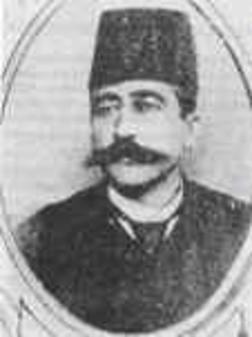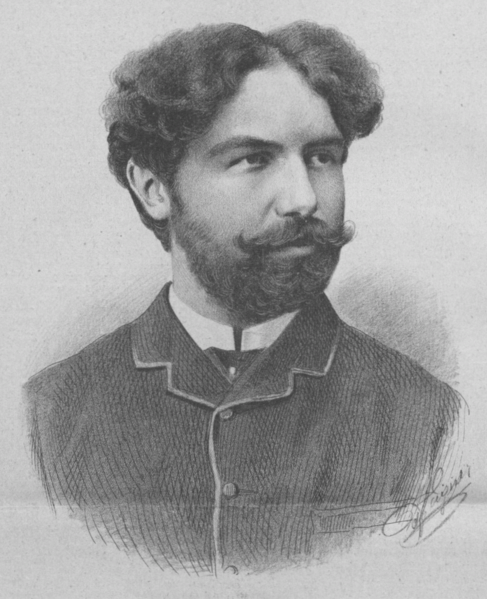<Back to Index>
- Composer Kemani Tatyos Ekserciyan, 1858
- Composer and Pianist Stéphan Elmas, 1862
PAGE SPONSOR

Tatyos Ekserciyan (1858 - March 13, 1913), or Tatyos Efendi, was a famous composer of classical Turkish music, and his works continue to be among the best remembered and often played pieces of the genre.
An Armenian from Istanbul, Tatyos Efendi was born in 1858 in the Ortaköy
district of Istanbul as the son of Monakyan (Manuti), a musician at the
Ortaköy Armenian Church. Tatyos Efendi's family had a minor
trading
business and when he finished the Ortaköy Armenian Elementary
School, he
started an apprenticeship at a locksmith and later became an apprentice
at a savat workshop (a traditional form of silver work). Due to his
deep interest in music, Tatyos Efendi left his apprenticeship and bought
a second hand kanun to receive his first music lessons from his uncle
Movzes Papazyan. He played the kanun with amateur groups and musical meetings in a family setting. Later, he took violin
lessons from Kemani Kör Sebuh and lessons in singing and theory
from
Andon and Civan brothers and singer Asdik Aga. He conducted many fasıl
concerts in various places including the Pirincci Gazino with artists
like Karakaş, Ovakim and Şemsi. He composed many popular songs and
instrumental works for fasıl.
Tatyos Efendi performed with many famous musicians of his time like Ahmed Rasim Bey, Civan and Andon brothers, Şevki Bey, Kemenceci Vasilaki and Tanburi Cemil Bey. His successful instrumental works show the influence of these collaborations. A poet as well as a composer, he often wrote the lyrics of most of his works. Tatyos Efendi's compositions successfully reflect the traditional aspects of the melodic forms and are a testimony to his superior understanding of the structure of Turkish classical music. The musicians that learned from him include Arşak Çömlekçiyan, Münir Mazhar Kamsoy, Nasibin Mehmet Yürü, Mustafa Sunar and Abdülkadir Töre.
The composer spent his last years alone in misery. His health ailing due to excessive alcohol consumption, he was alone except for the company of a few dedicated friends like Ahmed Rasim Bey. He died of cirrhosis of the liver on March 13, 1913 and Ahmed Rasim Bey gathered a dozen or so friends for his funeral and had him buried in the Kadıköy Uzunçayır Armenian Cemetery.
Although especially famous for his command of musical notation and
able to take down a tune to paper immediately at first hearing, many of
Tatyos Efendi's works were not written down and were lost in time. His
surviving works are the peşrevs in the Karcığar, Suznak, Rast makams (melodic form), the saz semais in the Hüseyni, Süznak, Rast makams and more than fifty songs in various makams.

Stéphan Elmas (Armenian: Ստեփան Էլմաս; 1862 - August 11, 1937) was an Armenian composer, pianist and teacher.
Elmas was born into a family of wealthy entrepreneurs in Smyrna (now İzmir), a city in the Ottoman Empire. It was soon discovered that the little boy was a child prodigy: he began taking piano lessons and writing short piano pieces under the tutelage of a local music teacher, Mr. Moseer, and already at the age of thirteen, the young virtuoso performed an all Liszt piano recital.
In July 1879, with the encouragement of his teacher but against the wishes of his family Stéphan Elmas left for Weimar, Germany, hoping to audition for Franz Liszt. Here he was able to meet the great master: Liszt advised him to go to Austria and work with Professor Anton Door at the Vienna Conservatory [a.k.a. University of Music and Performing Arts, Vienna] and Franz Kremm, the distinguished composer and church musician.
In Vienna, the seventeen year old Stéphan divided his time between studying the piano and composition, making his Vienna debut in 1885: an event which received many accolades in the press. Elmas continued to compose, writing many character pieces, including waltzes, mazurkas, nocturnes and impromptus. He dedicated his 6 Etudes (1881) to Franz Liszt and a number of pieces to Victor Hugo.
Elmas stayed in contact with Liszt and frequently sought his advice. In 1886, he briefly returned to his native Smyrna to attend his fathers funeral, but returned to Vienna convinced that Europe had much more to offer him. On February 24, 1887, he gave a highly successful recital in Viennas Saal Bösendorfer. A busy concert schedule followed, with Elmas scoring artistic triumphs in France, England, Germany, Austria and Italy. He mostly programmed his own works, but also performed Beethoven, Chopin and Schumann.
During his travels, Elmas became closely acquainted with, among others, the Russian composer and pianist Anton Rubinstein, the French composer Jules Massenet, the French pianist Joseph - Édouard Risler and the French lexicographer Guy de Lusignan. In 1912, he took up permanent residence in Geneva, Switzerland, where he continued to compose, teach and perform. Over time, Elmas became increasingly hard of hearing and grew somewhat of a bitter recluse, cutting himself off from the world.
Thankfully, he befriended Aimée Rapin (1868 1956), the armless Swiss painter, who nursed and consoled him during these difficult times. Elmas was also haunted by the tragic events of the 1915 Armenian Genocide by the Ottoman Turks. Fortunately, his family was able to escape to Athens following the Great Fire of Smyrna in 1922 which followed the Turkish occupation of the city.
Stéphan Elmas dictated his memoirs to Krikor - Hagop, a young journalist. His piano, along with his manuscripts and reminiscences, is now housed at the Charents Museum of Literature and Arts of Armenia. The composer died in Geneva and was buried in the citys Plainpalais cemetery.
Elmas composed rapidly and with great ease. Perhaps this explains why he sometimes did not revise his compositions sufficiently. However, many of his works are of high quality and perhaps he was most successful in composing his elegant and stylish salon pieces. These pieces seem to be composed for an earlier time: Elmass compositions tend to hearken back towards the style of earlier, Romantic composers, rather than forward to the challenging times that were shaping the musical world at the beginning of the new century.
Established in 1988 under the artistic guidance of Alexandre Siranossian, the Stéphan Elmas Foundation aims to disseminate the legacy of the Armenian composer. Recently, the composers works have been experiencing a revival, thanks to the efforts of pianist Armen Babakhanian.